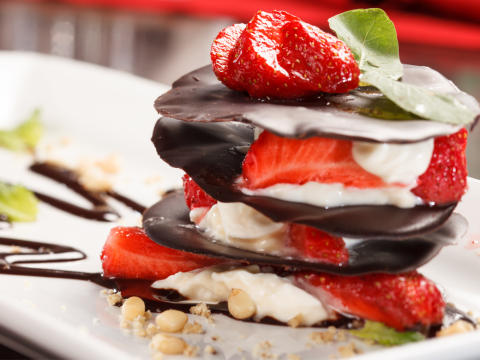The Art of Plating Dessert Like a Pro
Beauty speaks for itself. But you know what it says? That being pretty isn’t enough. To truly impress, you need to be neat, spark curiosity, and evoke emotion. The world’s greatest chefs learned this fast, and thus, the art of plating was born—arranging food on a plate before serving. Sure, a hearty stew may not allow for many flourishes, but dessert? Absolutely. So if you want to impress, do it the right way.
1. Add Color
In the world of plating, color “stains” are welcomed. Add raspberries to a dark chocolate cake to transform it from ordinary to a vibrant visual fantasy. Or place a few edible flowers over a sunny lemon tart. And just imagine a marble cheesecake drizzled with bright red strawberry sauce—far more artistic than one left plain from the oven.
2. Combine Textures
If all desserts were a mix of creamy and crunchy, meals would probably start—and end—with sweets. Mixing textures on a plate delights the eye and the palate. Try chocolate cream with crunchy wafer pieces and a few soft marshmallows. Or build a little tower from chocolate chips, strawberries, and whipped cream, sprinkled with almond brittle… who could resist?
3. Get Creative
Treat your plate like a blank canvas and let your inner Picasso shine. It’s a delicious cliché. Experiment freely and don’t be afraid to mess up—you can always start over with a new plate. Choose a minimalist approach on a rectangular plate with precisely placed elements. Or go romantic with a round plate centered on the sweetest component. Cut cake slices into unique shapes or pair round desserts with square plates. There’s no single right way—only the limits of your imagination (and patience).
4. Play With Temperature Contrast
If you can combine colors and textures, why not temperatures too? A freshly baked fruit pie becomes even more irresistible with a scoop of cold ice cream. Make sure the plate’s temperature matches the dessert: a hot plate will melt ice cream too fast, and can even wilt the dessert. For chilled summer treats, refrigerate plates for a few minutes before plating.
5. Tell a Story
People love stories—especially edible ones. The fastest way to impress is to build a narrative around your dessert. Choose a theme that suits you or the season: winter pastels, autumn colors, Christmas night, seaside or mountain escape, kids’ party, Halloween, etc. You don’t need to sculpt fondant! A mood or theme can be conveyed through colors, arrangement, or small elegant touches like edible flowers, chocolate ornaments, candied orange slices dipped in chocolate, macarons, or chocolate syrup drawings.
6. Don’t Overdo It
Keep the above tips in mind, but not all at once. When you have too many decorating ideas, choose only the most fitting. Anything can be tasteful—as long as it’s not excessive. A single dried orange slice on a chocolate cake can work wonders. The kind of wonders that leave guests speechless.
7. Height Matters
A tall cake can cause serving issues. It might require thin, unstable slices that topple easily, ruining your careful plating. Plus, it’s harder to eat with a spoon. Rule 1: if it looks too tall, it probably is. Rule 2: if it’s too tall, serve it on its side. You’ll still have room to decorate and guests will enjoy seeing every layer of sponge and filling. Score one for you!
8. Decorate Thoughtfully
No one wants a wilted mint leaf shoved into the center of their cake. Think about what your guests will see first, what will impress them, and how they’ll eat it. Whole nuts look nice beside a dessert, but you can’t easily pick them up with a dessert fork. And never use inedible items to decorate the plate!
9. Be Consistent
When plating for a larger group, try to keep portions and designs consistent. In other words, make sure all plates look the same. Staring at someone else’s plate is an international sport—at least make sure the “athletes” don’t find a slice twice as big or better decorated on another plate.


